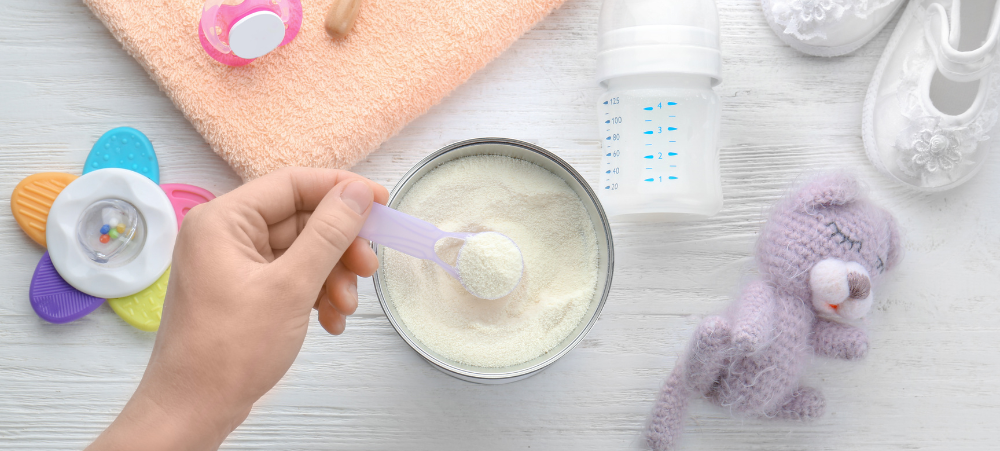Undoubtedly we all want what is best for our newborn baby’s, so what are the benefits surrounding breast-milk and commercial formula? Even the most prepared mother who has opted to breastfeed can land up by not being able too. Therefore if you are pregnant and considering your options then this certainly will be a read for you.
First we will look at breast milk – we all know that breast is best, so taking a look at why this is so is also important. Breast milk is amazing simply because it can change in composition depending on your baby’s needs.
Breast milk is a fully comprehensive meal in liquid form and is made up of many components:
Fat – If you were to remove all the water from breast milk, half of what is left behind is fat including a high level of cholesterol. These fats and cholesterol are vital because unlike adults, babies, toddlers and young children need high levels of fats for the development of the nervous system. These essential fats are needed to cover & protect nerve cells and are a crucial component of brain development.
Carbohydrates – About 37% of breast milk is made up of carbohydrates. While we often think of carbohydrates as bread, pasta and rice, in actual fact all sugars are carbohydrates. In breast milk, most of the carbohydrates are in the form of lactose, which is a milk sugar. Lactose provides your baby with energy so that she can do the things that babies do: breathe, eat, cry, wriggle, pass stools, learn, grow, and develop.
Proteins – Breast milk contains protein, which is essential for your baby’s growth. Colostrum is particularly high in protein, to stabilise your newborn’s blood sugar whereas mature milk has a slightly lower but consistent level of protein (1g per 100ml). As your baby grows her protein needs increase, so by six months of age, your baby will need to have protein from sources other than milk, in other words from solid foods.
Vitamins, Minerals, and More – Breast milk contains vitamins and minerals, which formula’s attempt to simulate. However, the nutritional composition of breast milk includes over 100 different components the effect and importance of which will be established in years to come.
Mature milk has many different kinds of proteins but the two major proteins are whey and casein. Whey is a smooth, liquidly-type of protein whereas casein is a coarse protein that tends to curdle. In breast milk, 60% to 80% of the proteins are of the whey type. Whey is easier to digest and it is absorbed well in your baby’s stomach, which is why breastfed babies will be hungry more often.
Reasons to breastfeed
Breast milk is the gold standard against which all formulas are measured for good reason:
Breast milk is the most complete form of nutrition for young babies. Your breast milk has just the right amount of fat, energy, water, and protein that is needed for a baby’s growth and development. For most babies breast milk is easier to digest than other alternatives.
Breast milk is the only milk that contains antibodies, which help to build your baby’s immune system. Breastfed babies are able to fight off infections and disease easier and are sick less often.
Exclusive breastfeeding for the first 4 months of life has been found to lower the risk of childhood obesity as well as Type 2 diabetes.
Exclusive breastfeeding for the first 4 months of life may also protect your child against allergies, especially allergic skin conditions like eczema.
Breastfeeding also has many benefits for you. Breastfeeding uses up some fat stores and helps you get back into your jeans. It also helps your uterus to return to its original size a lot sooner and lowers the risk of breast and ovarian cancers.
On a more practical level breastfeeding is convenient, it saves time and money. It is always available, at the right temperature and in a sterile ‘container’.
What is important to remember is that even if you are able to breastfeed for only a short period of time, your baby will experience numerous benefits from breast milk.
What about bottle-feeding?
Taking the decision to bottle-feed will be the right choice for you and your baby if thought through carefully and upon advice of a medical professional. When it comes to parenting you are the only expert on your baby and although you must heed advice, ultimately a choice that makes you feel most comfortable and relaxed is the right choice for you and your baby. Feeding your baby expressed breast milk in a bottle will have the same benefits as breastfeeding and modern infant formula preparations are an excellent source of nutrition for your baby. For mothers who are unable to breastfeed or who decide not to, infant formula is a good alternative. If you feed your baby with a commercially prepared formula, be assured that your baby’s nutritional needs will be met.
Things to consider when choosing your baby’s formula:
While breastfeeding is the best nutrition for babies, commercially prepared infant formulas are a nutritious alternative to breast milk. Manufactured under sterile conditions, commercial formulas attempt to duplicate mother’s milk using a complex combination of proteins, sugars, fats, and vitamins that would be virtually impossible to create at home. So, if you don’t breastfeed your baby, it’s important that you use only a commercially prepared formula. If your baby is very irritable, has excessive gas, diarrhoea (which may be bloody), spitting up, vomiting, and poor weight gain she may be intolerant to the formula she is on.
Choosing another type of baby formula, in consultation with a dietician, nursing sister or paediatrician may help alleviate the symptoms. Simply changing brands, unless you also change formula types, does not usually make a difference. You should not self diagnose your baby’s problems and decide to simply switch formula. You are more likely to create problems by uninformed formula switching.
If you have a problem you think is related to your baby’s formula, speak to your doctor or clinic sister.
What types of Formula are on the market?
Cow’s milk-based formula: This will be your first choice of formula if you have moved your baby from breast milk.
Formula for fussy babies: This would have less lactose than regular milk based formula and is for babies with some gas or who are very fussy on milk-based formula.
Formula for constipated babies: This has more lactose than regular milk based formula and is for babies with some constipation on milk-based formula.
Lactose-free formula: This is a milk that contains no lactose. These should only be used under the guidance of a dietician or paediatrician after a confirmed diagnosis of lactose intolerance.
Formula for babies with excessive acid reflux: These are thickened formula’s – note do not use thickening agents, and are for babies with confirmed reflux that interferes with growth.
Soy formula: This is a soya based milk and is for babies with lactose intolerance, and milk protein allergies but it must be noted that studies have shown that the use of soy milk or goats milk formula does not prevent the development of allergies in children.
Formula for failing to thrive and low weight gain: These have more protein and calories in the form of healthy fats and are used if your baby is failing to thrive or with very poor weight gain.
Formula for premature babies: These have more calories and specific nutrients and are use for premature and low-birth weight babies.
Follow on formula: These are fortified cow and soya milk and are for older infants and toddlers between the ages of 12 and 36 months of age.
Hypoallergenic formulas: These are formulas where a small amount of the protein is pre-digested. They were originally designed to reduce the incidence of allergy in high risk children have shown very little benefit and your baby would be better on a normal cows milk based formula or if allergic on a specialised semi- elemental formula or amino acid based formula
We understand that there are many aspects that encompass a Mother, Father or Child and strive toward providing resources and services that accommodates this.
Our content is aimed to inform and educate families on issues starting from pregnancy through to the challenges of the teen-age years.
- Tips for Breastfeeding in Public: Confidence and Comfort - November 20, 2025
- Eskort launches Kiddos: South Africa’s first pork range made just for kids - November 13, 2025
- Putting the Power of Learning in Learners’ Hands During Global Education Week - November 12, 2025





